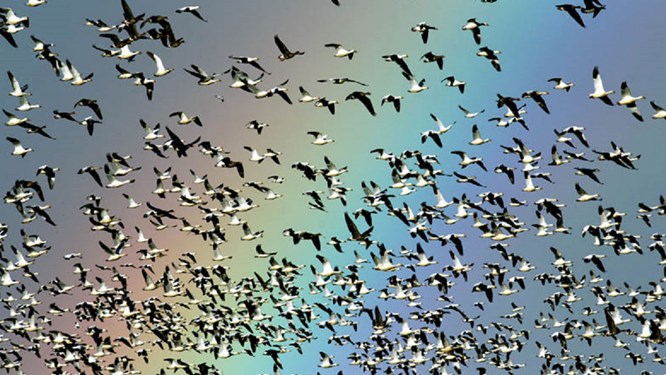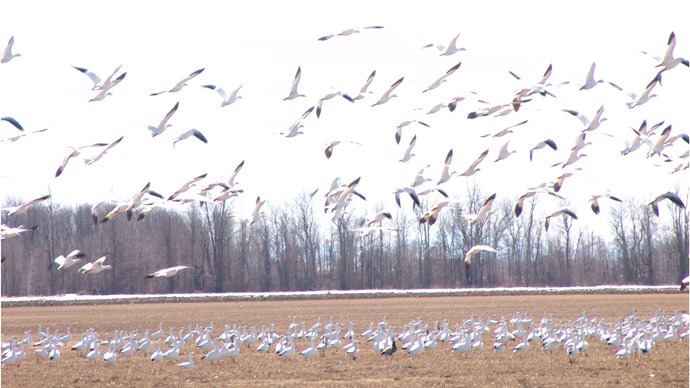No Limits: Conservation Season is a Great Time to Take Up Waterfowl Hunting
Tags:
No Limits: Conservation Season is a Great Time to Take Up Waterfowl Hunting
The Light Goose Conservation Order is an extended season created to control certain geese populations, suspending many regulations in place during regular waterfowl season.
by HEIDI LYN RAO posted on January 14, 2024
Support NRA Women DONATE

When all the other hunting seasons are coming to a close, waterfowl season is still going strong. This is the time of year when many deer hunters put away their rifles, pick up their shotguns and head to the field to hunt waterfowl. Waterfowl is a classification of birds that comprises ducks, which include coots, mergansers and geese.
The group of birds called geese include light geese and dark geese. Light geese include snows, lesser snows and Ross’s geese. Dark geese are made up of numerous birds including Canada, speckled belly, and brants. It is essential that you are able to identify waterfowl before you shoot. In other words, no ground checking—Know Your Birds!
Waterfowl hunting is one of the hardest hunts in which to participate. It is not because waterfowl are that difficult to hunt, but because of the long list of complicated laws that you must follow to remain legal. The laws regarding baited fields, calling devices and legal shotguns are enough to keep many hunters choosing to pursue other game animals. For example, I have given a four-hour presentation solely on what constitutes a baited field. Individuals new to waterfowl hunting should become very familiar with the regulations regarding migratory birds. It is advisable to hunt with experienced waterfowl hunters to learn the laws.

Image:Hazel Holby/U.S. Fish & Wildlife Service
Migratory bird regulations are set by the U.S. Fish and Wildlife Service (FWS) and adopted by the states. This means anyone hunting migratory birds can be inspected by both federal game wardens and state game wardens. Likewise, any violations of the law are also a violation of the Migratory Bird Treaty Act of 1918 and a federal violation as well as a state violation. This can be very intimidating to a new waterfowl hunter.
There are some basic laws regarding hunting migratory waterfowl that every hunter must know. First you must do your research and know the daily bag limit of migratory birds that you can be in possession of. Other laws that you must be familiar with are the prohibition of using electronic calls, hunting with a shotgun capable of holding no more than three shells, and knowing the legal shooting hours. The last thing anyone hunting waterfowl wants to do is run afoul of the law—pun intended!
What if you could take up waterfowl hunting and legally disregard the basic laws when hunting migratory birds? This would be the ideal scenario for first time waterfowlers! First time waterfowl hunters could learn to hunt certain migratory birds while worrying less about breaking the law. Believe it or not, this season does exist! Commonly referred to as the Conversation Season, it was formally called the Light Goose Conservation Order.
Light Goose Conservation Order
In 1998, the Arctic Goose Joint Venture (AGJV) was created to address the issue of the rapid increase in snow goose populations in the Central, Mississippi and Atlantic Flyways. The numbers of snow geese have grown so large that the species is creating environmental problems. To address the problem, the Light Goose Conservation Order, or Conversation Season, was created. The Conservation Season is an extended season for the hunting of light geese only to help control their populations.
What’s notable about the Conservation Season is the suspension of the basic laws you must follow when hunting waterfowl during the regular season. During the Conservation season there are no bag limits; the use of electronic calls are permitted; unplugged shotguns that can hold more than three shells are permitted; and shooting hours will extend from 30 minutes before sunrise to 30 minutes after sunset. The suspension of laws is to allow hunters to take as many light geese as possible for the purpose of reducing numbers.
Conservation season varies from state to state, so it is your responsibility to know when the season starts and when the season ends. For example, in Texas, Light Goose Conservation Order season is from Jan. 29, 2024 to March 10, 2024 in the East Zone; and Feb. 5, 2024 to March 10, 2024 in the West Zone. This means if you are hunting in Texas, you need to know the East Zone and West Zone boundaries. To complicate matters, there is an area along the Central Gulf Coast in the East Zone that is closed to the taking of light geese after March 5, 2024. Anyone in the Matagorda area must know the location of these boundaries.
Legal geese in the Light Goose Conservation Order season include snow geese, lesser snow geese, and Ross’s geese.

Greater Snow Geese
Snow geese (Anser caerulescens) are white birds that also can come in a dark morph or in a dark phase. A snow goose in a dark phase is often called a Blue Goose. The snow goose is a large bird weighing up to 10 lbs. with a wingspan of up to 3 feet. An identifying feature of the snow goose is the presence of “black lips” between the upper and lower beak. This goose breeds in Canada, Greenland and Russia, and winters in the United States, along the Gulf Coast, and Mexico.

Lesser Snow Geese
Lesser snow geese (Chen caerulescens caerulescens) are white birds and, like the greater snow goose, can come in a dark morph or dark phase. The lesser snow goose is smaller than the greater snow goose weighing between 5 lbs. and 6 lbs. with a wingspan up to 30 inches. Also like the greater snow goose, the lesser snow goose has the “black lips” between the upper and lower beaks. These geese are the most numerous and the noisiest of the geese. Lesser snow geese share the same breeding areas with greater snow geese and sometimes can interbreed producing offspring.
Ross’s Geese
Ross’s geese (Anser rossii) are white geese that rarely have a dark morph or dark phase. This small goose is roughly half the size of the greater snow goose. A Ross’s goose weighs up to 5 lbs. with a wingspan of up to 30 inches. This goose lacks the “black lips” that the other two white geese have. The breeding area of the Ross’s goose is in the arctic areas wintering in the central United States and the Gulf Coast.
If waterfowl hunting is something you have been thinking about, the Light Goose Conservation Order Season is a great time to start. Hunting is one of the best conservation methods in which to participate and hunting light geese is not only fun but helps the environment. The Arctic Goose Joint Venture agrees. It is up to hunters to conserve the species. During the Light Goose Conservation Order Season there are lots of birds and lots of shooting—that is, if you are where the geese are!

